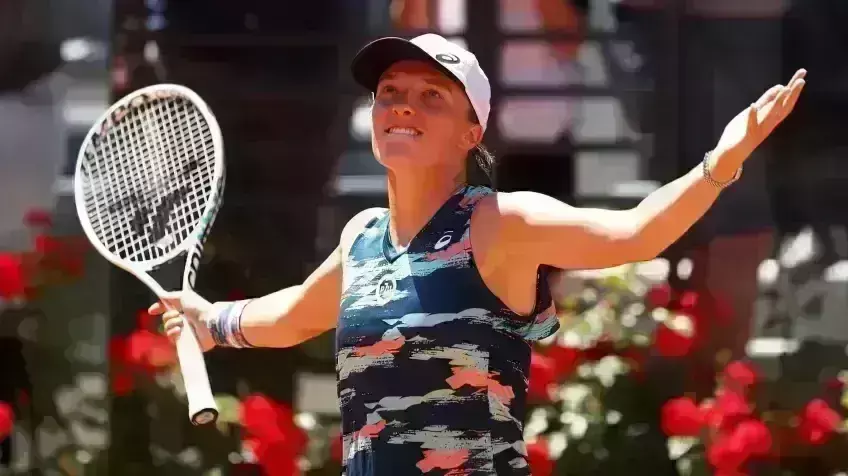Could Iga Swiatek Be The Next Dominant Player?
Goodbye Serena Williams

Ever since the decline and fall of Serena Williams women's tennis has become an open field. In the absence of a dominant player this is bound to happen and right now the field is even more open.
The nearest women's tennis came to producing a dominant player appeared to be Ashleigh Barty. The Aussie won the Australian Open (2022), the French Open (2019) and Wimbledon (2021), had risen to the No 1 ranking and with 15 career titles by the age of 25 she certainly looked to be the next big thing in women's tennis.
Dramatically, however, Barty announced her retirement in March this year, two months after winning the Australian Open. She was still ranked No 1 having held the ranking for all but four weeks between June 2019 and April this year when she relinquished the ranking.
The affable Barty who also had a game that endeared itself to the tennis going public was extremely popular and her departure left a void in the game in more ways than one.
The open field is best driven home by the fact that since Serena won her last Grand Slam in 2017 – the Australian Open which left her with 23 career Grand Slam singles titles, one short of the all-time record held by Australia's Margaret Court. The 23 Grand Slams have been won by no less than 14 different players. At various times Garbine Muguruza, Victoria Azarenka, Angelique Kerber, Naomi Osaka, Simona Halep and Barty by their performances at Grand Slam events and fortified by their No 1 ranking have all bid fair to become the dominant player around the WTA circuit.
But Barty has retired and the others have since slipped in the rankings. Emma Raducanu briefly came across like a whiff of fresh air when she won the US Open last year after coming through the qualifying rounds. Great things were predicted for her but injuries and lack of form have seen her slide currently to 75 in the rankings.
However, around the tennis circuit there are always new stars who are ready to replace the fading ones to see that interest in the women's game is maintained. The latest is Caroline Garcia who became only the second French woman to win the year-ending WTA Tour finals.
The 29-year-old Garcia reached a career high ranking of No 4 in 2018 but loss of form saw her slide to 74th at the start of this year. She had not gone beyond the quarterfinal of a Grand Slam but 2022 changed all that. For starters she made the semifinals of the US Open before going down to fifth seed Ons Jabeur a defeat that snapped a 13-match winning streak.
As a result she was back in the top ten and in the ATP Tour finals she was at her best defeating Maria Sakkari in the semifinals and Aryna Sabalenka in the title round for the biggest win of her career. This brought her back to No 4 in the latest WTA rankings.
Sakkari herself seems destined for bigger things.
The 27-year-old Greek reached a career best ranking of No 3 in March this year and closed 2022 at the No 6 spot. The farthest she has gone in Grand Slams is the semifinals at the French Open and US Open last year but her consistent performances around the circuit has made her a tough opponent.
But perhaps more than Sakkari, the player to look out for in 2023 will be Jabeur. The 28-year-old from Tunisia has had an outstanding year having reached both the Wimbledon and US Open finals pushing her up to No 2 in the year- end rankings.
Another player who bids fair to make a strong presence on the circuit next year is Jessica Pegula. The 28-year-old American made the quarterfinals of three of the four Grand Slams and cemented her rising stature by winning the Guadalajara Open, a WTA 1000 event for the biggest title of her career. Pegula who has been climbing up the ladder steadily through the last few years is now enjoying a career best ranking of No 3.
Of course players like Elena Rybakina (this year's Wimbledon champion), Aryna Sabalenka, Coco Gauff, Jelana Ostapenko and Petra Kvitova along with other established stars will continue to be among the leading players but despite the growing challenge from a number of players going into 2023 the main focus will still be on Iga Swiatek. The 21- year-old from Poland is not just ranked No 1 she is so far ahead of the second placed Jabeur that it is already difficult to see her dethroned next year.
Despite a surprising exit at the semifinal stage of the WTA Tour event when she went down to Sabalanka Swiatek courtesy of Grand Slam triumphs at the French Open and US Open was the dominant player of the year. Following back back WTA 1000 titles at Qatar and Indian Wells she reached a career high ranking of No 2 in March and with the retirement of Barty she took over as No 1 in April and cemented that exalted status by the end of the year.
She also became the first woman to win the first three WTA 1000 events of the year and enjoyed a 37-match winning streak, the longest on the WTA Tour in the 21st century. By the end of the year Swiatek had posted a 67 – 9 win loss record, the most wins in a single season since Serena in 2013.
She also became the first player since Serena in 2013 to collect over 11,000 ranking points in a single season. Despite several challengers Swiatek will be the one to beat in 2023. Could she be the next dominant player?



